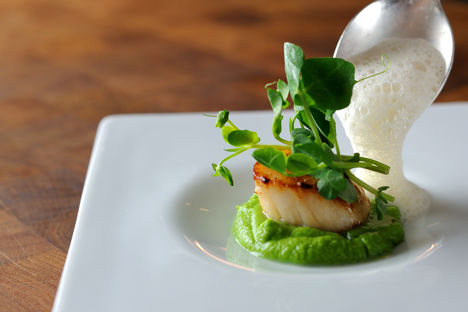Yet another culinary technique popularised by modernist chef Ferran Adrià, espuma (the Spanish word for foam or froth) is now widespread on fine-dining menus – to the point where it has come to be seen as a little passé. While critics often view foams as over-fussy, unnecessary and somewhat outdated, in fact, the technique has been used for centuries; cappuccino, anyone? Moreover, when harnessed appropriately, foams can add wonderful textural nuance to a dish – and textural nuance should always be encouraged when it comes to creating multi-layered, interesting food.
Essentially, foams are just aerated liquids; and their density will depend on the thickness of the liquid and the ratio of liquid to air. A lighter foam may be more accurately described as froth – such as the head of a beer or cappuccino – while a denser foam will resemble mousse. But whether you are striving for froth, mousse, foam or even ‘air’, the methods are likely to be similar.
Though it is possible to create foams without the use of artificial stabilisers (as with eggs, milk, butter etc.), the introduction of ingredients such as lecithin – brought to prominence by Adrià in the 1990s – paved the way for chefs to ‘jush-up’ less-stable liquids (stocks, sauces, juices etc.). Lecithin works in a similar way to the proteins in egg and milk – acting as an emulsifier to hold the shape of the foam – and the amount you disperse into the liquid should depend on how stiff you want it to be. Whether using lecithin or alternatives such as agar agar, gellan gum and gelatine, though, it is important to note that for a liquid to translate into a foam it must contain elements of either lecithin, monoglycerides (emulsifying fats) or protein.
Equipment
Creating a culinary foam is easier than it looks, and - unlike some other modernist techniques – the appropriate equipment won’t require you to break the bank.
There are two main implements that are used to make a foam. One of them you may already have in your cupboard; the handheld immersion blender. This particular tool is expert at whipping up lighter foams (froth) but less successful when it comes to preparing espuma of the Ferran Adrià variety. For denser foams, it is probably wise to invest in an espuma gun – which is designed for this very task and uses gas canisters of N2O (Nitrous Oxide).
Uses
The joy of foams is that they can be both sweet and savoury. Examples of sweet foams include James Sommerin’s cardamom espuma and Simon Haigh’s banana espuma, but there are a diverse amount of options available - so don’t limit yourself. Ferran Adrià’s forty-second sponge cake, which is made with an espuma gun and a microwave, represents a more adventurous application of the equipment.
Savoury foams – like Colin McGurran’s ham version – tend to be made from watered down purées (though viscous enough to remain stable) and used to sauce the other components on the plate. If you are preparing a warm foam, be careful not to overheat it – exceeding 60°C is generally a bad idea.
At the other end of the spectrum is frozen foam – which can be made as simply as the term suggests, though ideally you would use a blast chiller rather than a household freezer. Dehydrated foam is another intriguing prospect, and has a wonderful meringue-like texture.
Get in touch
Please sign in or register to send a comment to Great British Chefs.



